YAMAHA SR125 2000 Service Manual
Manufacturer: YAMAHA, Model Year: 2000, Model line: SR125, Model: YAMAHA SR125 2000Pages: 78, PDF Size: 8.59 MB
Page 41 of 78
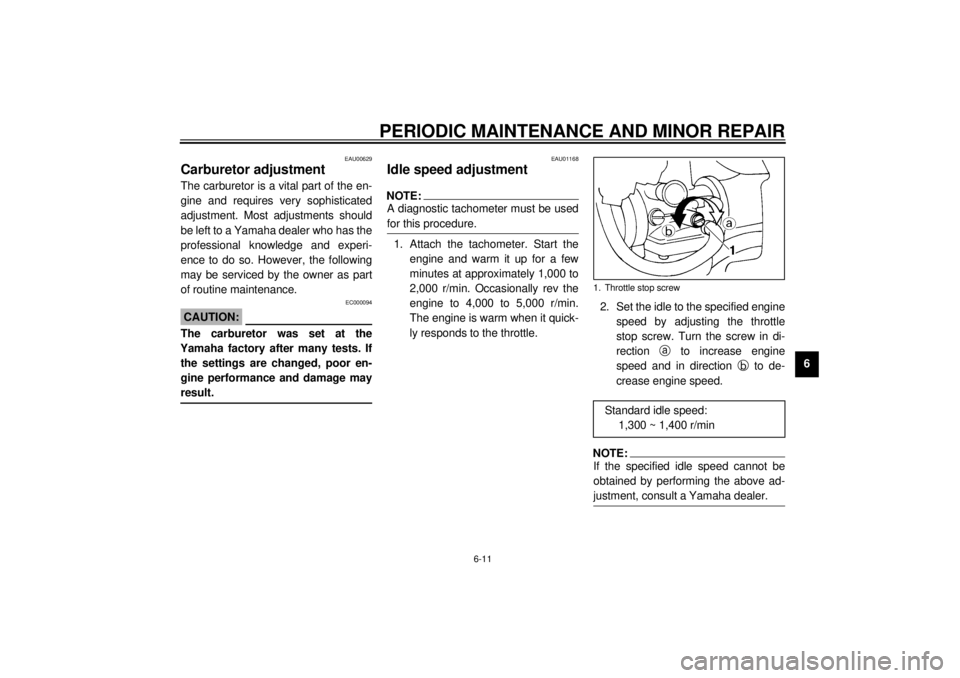
PERIODIC MAINTENANCE AND MINOR REPAIR
6-11
6
EAU00629
Carburetor adjustmentThe carburetor is a vital part of the en-
gine and requires very sophisticated
adjustment. Most adjustments should
be left to a Yamaha dealer who has the
professional knowledge and experi-
ence to do so. However, the following
may be serviced by the owner as part
of routine maintenance.
EC000094
CAUTION:@ The carburetor was set at the
Yamaha factory after many tests. If
the settings are changed, poor en-
gine performance and damage may
result. @
EAU01168
Idle speed adjustmentNOTE:@ A diagnostic tachometer must be used
for this procedure. @1. Attach the tachometer. Start the
engine and warm it up for a few
minutes at approximately 1,000 to
2,000 r/min. Occasionally rev the
engine to 4,000 to 5,000 r/min.
The engine is warm when it quick-
ly responds to the throttle.2. Set the idle to the specified engine
speed by adjusting the throttle
stop screw. Turn the screw in di-
rection
a to increase engine
speed and in direction
b to de-
crease engine speed.
NOTE:@ If the specified idle speed cannot be
obtained by performing the above ad-
justment, consult a Yamaha dealer. @1. Throttle stop screwStandard idle speed:
1,300 ~ 1,400 r/min
E_3mw.book Page 11 Monday, February 5, 2001 9:54 AM
Page 42 of 78
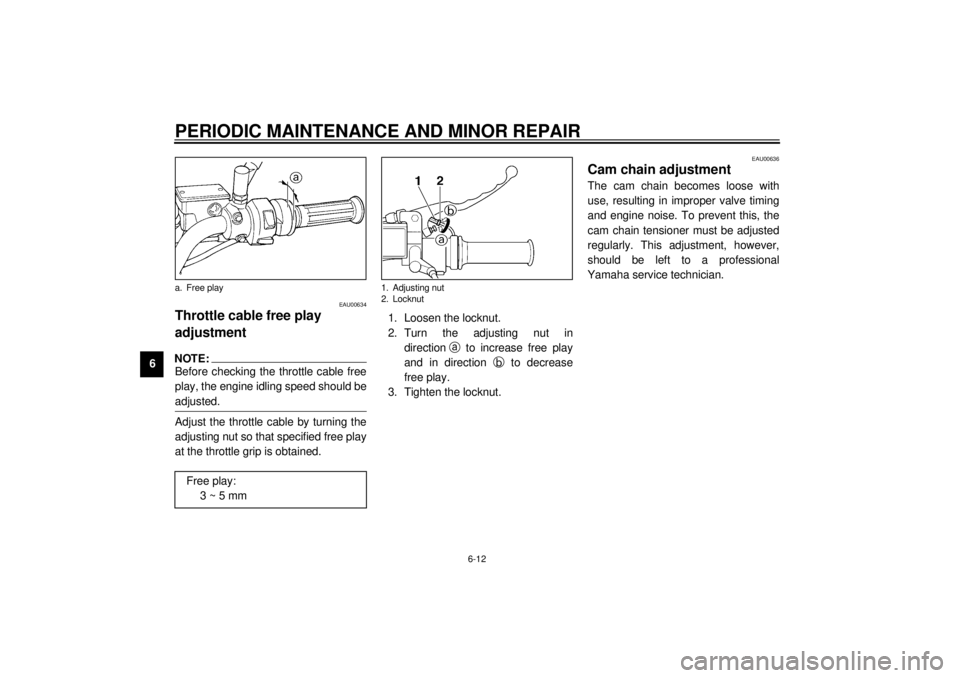
PERIODIC MAINTENANCE AND MINOR REPAIR
6-12
6
EAU00634
Throttle cable free play
adjustmentNOTE:@ Before checking the throttle cable free
play, the engine idling speed should be
adjusted. @Adjust the throttle cable by turning the
adjusting nut so that specified free play
at the throttle grip is obtained.1. Loosen the locknut.
2. Turn the adjusting nut in
direction
a to increase free play
and in direction
b to decrease
free play.
3. Tighten the locknut.
EAU00636
Cam chain adjustmentThe cam chain becomes loose with
use, resulting in improper valve timing
and engine noise. To prevent this, the
cam chain tensioner must be adjusted
regularly. This adjustment, however,
should be left to a professional
Yamaha service technician.
a. Free playFree play:
3 ~ 5 mm
1. Adjusting nut
2. Locknut
E_3mw.book Page 12 Monday, February 5, 2001 9:54 AM
Page 43 of 78
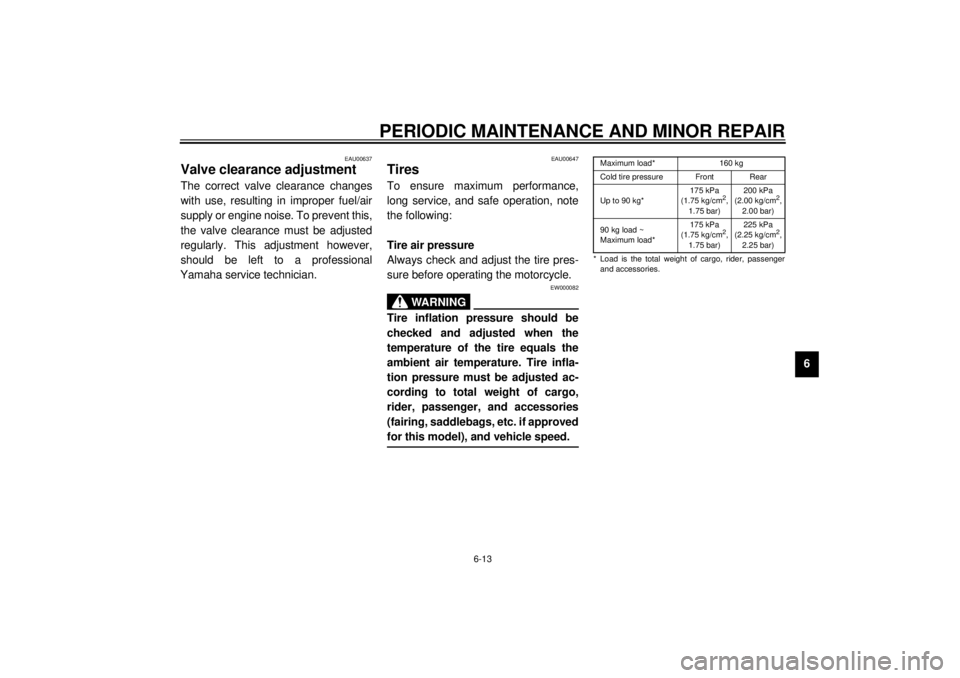
PERIODIC MAINTENANCE AND MINOR REPAIR
6-13
6
EAU00637
Valve clearance adjustmentThe correct valve clearance changes
with use, resulting in improper fuel/air
supply or engine noise. To prevent this,
the valve clearance must be adjusted
regularly. This adjustment however,
should be left to a professional
Yamaha service technician.
EAU00647
TiresTo ensure maximum performance,
long service, and safe operation, note
the following:
Tire air pressure
Always check and adjust the tire pres-
sure before operating the motorcycle.
EW000082
WARNING
@ Tire inflation pressure should be
checked and adjusted when the
temperature of the tire equals the
ambient air temperature. Tire infla-
tion pressure must be adjusted ac-
cording to total weight of cargo,
rider, passenger, and accessories
(fairing, saddlebags, etc. if approved
for this model), and vehicle speed. @
CE-32EMaximum load* 160 kg
Cold tire pressure Front Rear
Up to 90 kg*175 kPa
(1.75 kg/cm
2,
1.75 bar)200 kPa
(2.00 kg/cm
2,
2.00 bar)
90 kg load ~
Maximum load*175 kPa
(1.75 kg/cm
2,
1.75 bar)225 kPa
(2.25 kg/cm
2,
2.25 bar)
* Load is the total weight of cargo, rider, passenger
and accessories.
E_3mw.book Page 13 Monday, February 5, 2001 9:54 AM
Page 44 of 78

PERIODIC MAINTENANCE AND MINOR REPAIR
6-14
6
EW000083
WARNING
@ Proper loading of your motorcycle
is important for several characteris-
tics of your motorcycle, such as
handling, braking, performance and
safety. Do not carry loosely packed
items that can shift. Securely pack
your heaviest items close to the
center of the motorcycle, and dis-
tribute the weight evenly from side
to side. Properly adjust the suspen-
sion for your load, and check the
condition and pressure of your tires.
NEVER OVERLOAD YOUR MOTOR-
CYCLE. Make sure the total weight
of the cargo, rider, passenger, and
accessories (fairing, saddlebags,
etc. if approved for this model) does
not exceed the maximum load of the
motorcycle. Operation of an over-
loaded motorcycle could cause tire
damage, an accident, or even injury. @
Tire inspection
Always check the tires before operating
the motorcycle. If center tread depth
reaches the limit as shown, if the tire
has a nail or glass fragments in it, or if
the side wall is cracked, contact a
Yamaha dealer immediately and have
the tire replaced.CE-10ECE-26E
NOTE:@ These limits may be different by regula-
tion from country to country. If so, con-
form to the limits specified by the
regulations of your own country. @
1. Side wall
a. Tread depthFRONT
Manufacturer Size Type
Inoue 3.00-17 45P 8F
REAR
Manufacturer Size Type
Inoue 3.50-16 52P 8RA
Minimum tire tread depth
(front and rear)1.6 mm
E_3mw.book Page 14 Monday, February 5, 2001 9:54 AM
Page 45 of 78

PERIODIC MAINTENANCE AND MINOR REPAIR
6-15
6
EAU00681
WARNING
@ l
Operating the motorcycle with
excessively worn tires decrease
riding stability and can lead to
loss of control. Have excessive-
ly worn tires replaced by a
Yamaha dealer immediately.
Brakes, tires, and related wheel
parts replacement should be
left to a Yamaha Service Techni-
cian.
l
Patching a punctured tube is
not recommended. If it is abso-
lutely necessary to do so, use
great care and replace the tube
as soon as possible with a good
quality replacement.
@
EAU00685
WheelsTo ensure maximum performance,
long service, and safe operation, note
the following:l
Always inspect the wheels before
a ride. Check for cracks, bends or
warpage of the wheel. Be sure the
spokes are tight and undamaged.
If any abnormal condition exists in
a wheel, consult a Yamaha dealer.
Do not attempt even small repairs
to the wheel. If a wheel is de-
formed or cracked, it must be re-
placed.
l
Tires and wheels should be bal-
anced whenever either one is
changed or replaced. Failure to
have a wheel balanced can result
in poor performance, adverse han-
dling characteristics, and short-
ened tire life.
l
Ride at moderate speeds after
changing a tire since the tire sur-
face must first be broken in for it to
develop its optimal characteristics.
E_3mw.book Page 15 Monday, February 5, 2001 9:54 AM
Page 46 of 78
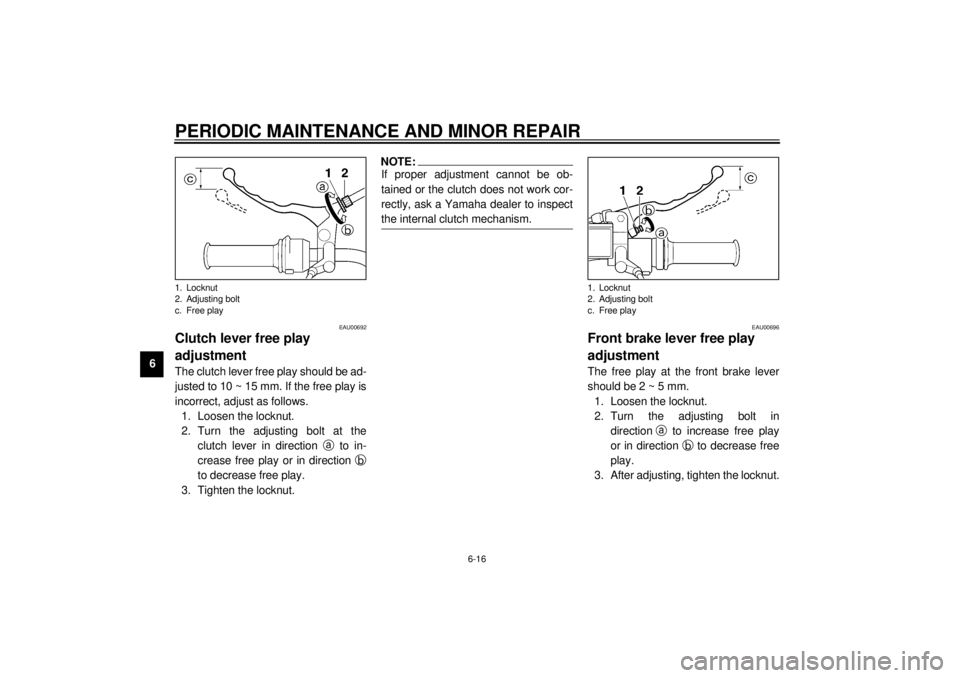
PERIODIC MAINTENANCE AND MINOR REPAIR
6-16
6
EAU00692
Clutch lever free play
adjustmentThe clutch lever free play should be ad-
justed to 10 ~ 15 mm. If the free play is
incorrect, adjust as follows.
1. Loosen the locknut.
2. Turn the adjusting bolt at the
clutch lever in direction
a to in-
crease free play or in direction
b
to decrease free play.
3. Tighten the locknut.
NOTE:@ If proper adjustment cannot be ob-
tained or the clutch does not work cor-
rectly, ask a Yamaha dealer to inspect
the internal clutch mechanism. @
EAU00696
Front brake lever free play
adjustmentThe free play at the front brake lever
should be 2 ~ 5 mm.
1. Loosen the locknut.
2. Turn the adjusting bolt in
direction
a to increase free play
or in direction
b to decrease free
play.
3. After adjusting, tighten the locknut.
1. Locknut
2. Adjusting bolt
c. Free play
1. Locknut
2. Adjusting bolt
c. Free play
E_3mw.book Page 16 Monday, February 5, 2001 9:54 AM
Page 47 of 78
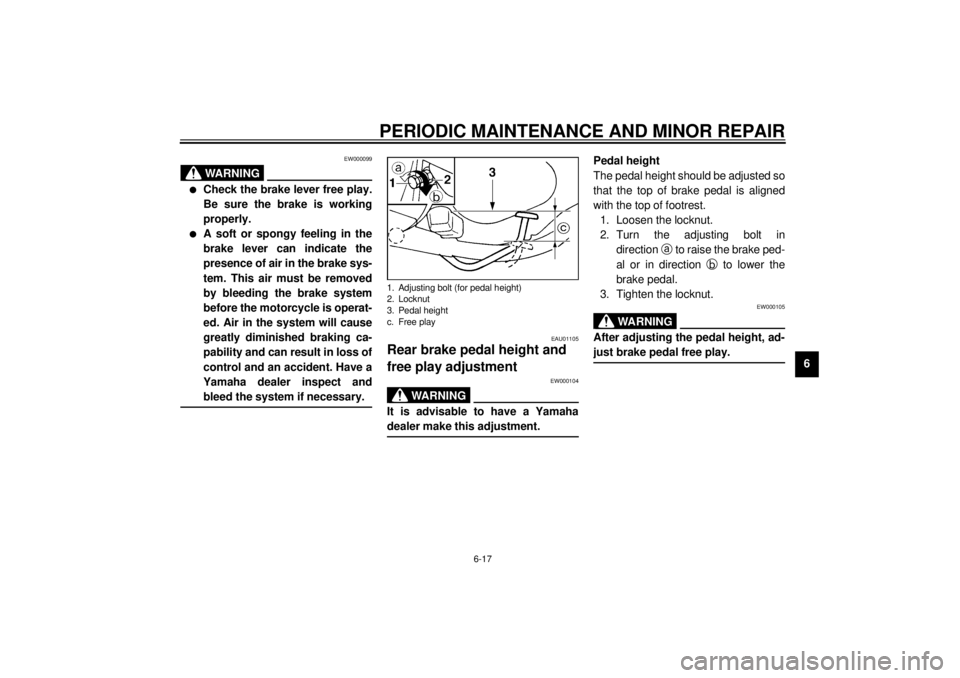
PERIODIC MAINTENANCE AND MINOR REPAIR
6-17
6
EW000099
WARNING
@ l
Check the brake lever free play.
Be sure the brake is working
properly.
l
A soft or spongy feeling in the
brake lever can indicate the
presence of air in the brake sys-
tem. This air must be removed
by bleeding the brake system
before the motorcycle is operat-
ed. Air in the system will cause
greatly diminished braking ca-
pability and can result in loss of
control and an accident. Have a
Yamaha dealer inspect and
bleed the system if necessary.
@
EAU01105
Rear brake pedal height and
free play adjustment
EW000104
WARNING
@ It is advisable to have a Yamaha
dealer make this adjustment. @
Pedal height
The pedal height should be adjusted so
that the top of brake pedal is aligned
with the top of footrest.
1. Loosen the locknut.
2. Turn the adjusting bolt in
direction
a to raise the brake ped-
al or in direction
b to lower the
brake pedal.
3. Tighten the locknut.
EW000105
WARNING
@ After adjusting the pedal height, ad-
just brake pedal free play. @
1. Adjusting bolt (for pedal height)
2. Locknut
3. Pedal height
c. Free play
E_3mw.book Page 17 Monday, February 5, 2001 9:54 AM
Page 48 of 78

PERIODIC MAINTENANCE AND MINOR REPAIR
6-18
6Free play
The free play at the end of the brake
pedal should be approximately 20 ~
30 mm. Turn the adjusting nut in direc-
tion
a to increase the brake pedal free
play or in direction
b to reduce the
brake pedal free play.
EW000103
WARNING
@ Check the operation of the brake
light after adjusting the rear brake. @
EAU01646
Brake light switch adjustmentThe rear brake light switch is activated
by the brake pedal and is properly ad-
justed when the brake light comes on
just before braking takes effect. Adjust
the brake light switch as follows.
1. Remove panel A.
2. Remove the battery cover by re-
moving the screw.3. Hold the switch body so it does not
rotate while turning the adjusting
nut.
4. Turn the adjusting nut in
direction
a to make the brake
light come on earlier. Turn the ad-
justing nut in direction
b to make
the brake light come on later.
1. Adjusting nut
1. Battery cover
2. Screw
1. Brake light switch
2. Adjusting nut
E_3mw.book Page 18 Monday, February 5, 2001 9:54 AM
Page 49 of 78
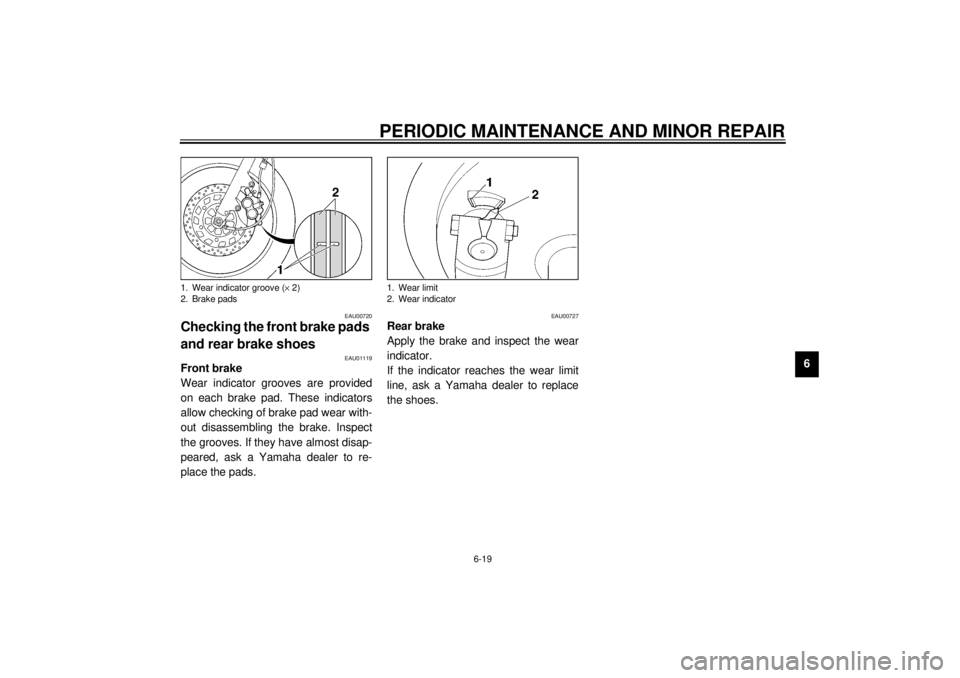
PERIODIC MAINTENANCE AND MINOR REPAIR
6-19
6
EAU00720
Checking the front brake pads
and rear brake shoes
EAU01119
Front brake
Wear indicator grooves are provided
on each brake pad. These indicators
allow checking of brake pad wear with-
out disassembling the brake. Inspect
the grooves. If they have almost disap-
peared, ask a Yamaha dealer to re-
place the pads.
EAU00727
Rear brake
Apply the brake and inspect the wear
indicator.
If the indicator reaches the wear limit
line, ask a Yamaha dealer to replace
the shoes.
1. Wear indicator groove (´ 2)
2. Brake pads
1. Wear limit
2. Wear indicator
E_3mw.book Page 19 Monday, February 5, 2001 9:54 AM
Page 50 of 78
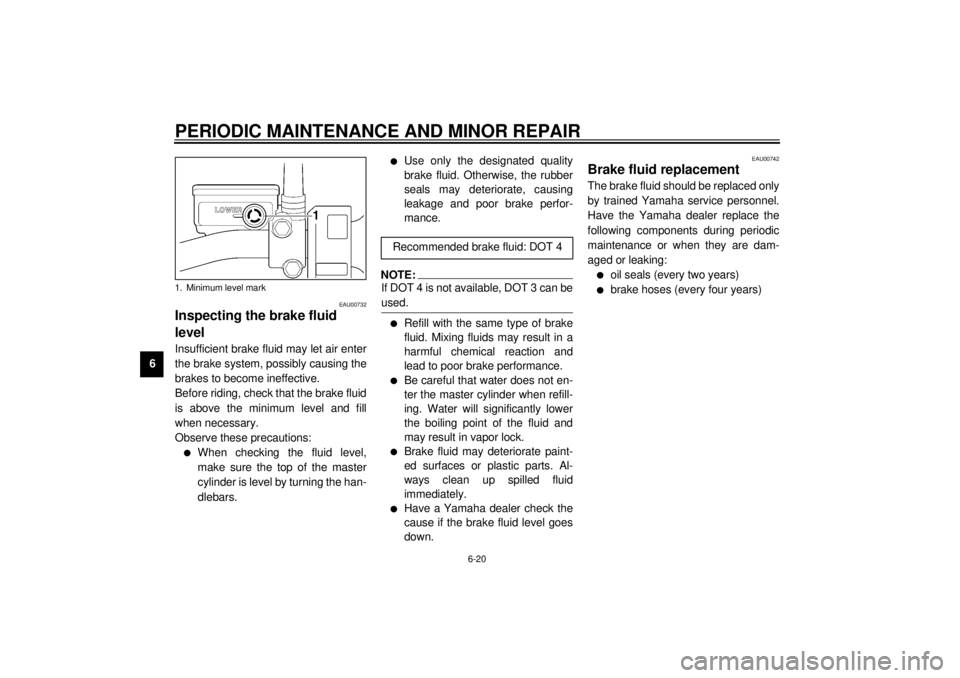
PERIODIC MAINTENANCE AND MINOR REPAIR
6-20
6
EAU00732
Inspecting the brake fluid
levelInsufficient brake fluid may let air enter
the brake system, possibly causing the
brakes to become ineffective.
Before riding, check that the brake fluid
is above the minimum level and fill
when necessary.
Observe these precautions:l
When checking the fluid level,
make sure the top of the master
cylinder is level by turning the han-
dlebars.
l
Use only the designated quality
brake fluid. Otherwise, the rubber
seals may deteriorate, causing
leakage and poor brake perfor-
mance.
NOTE:@ If DOT 4 is not available, DOT 3 can be
used. @l
Refill with the same type of brake
fluid. Mixing fluids may result in a
harmful chemical reaction and
lead to poor brake performance.
l
Be careful that water does not en-
ter the master cylinder when refill-
ing. Water will significantly lower
the boiling point of the fluid and
may result in vapor lock.
l
Brake fluid may deteriorate paint-
ed surfaces or plastic parts. Al-
ways clean up spilled fluid
immediately.
l
Have a Yamaha dealer check the
cause if the brake fluid level goes
down.
EAU00742
Brake fluid replacementThe brake fluid should be replaced only
by trained Yamaha service personnel.
Have the Yamaha dealer replace the
following components during periodic
maintenance or when they are dam-
aged or leaking:l
oil seals (every two years)
l
brake hoses (every four years)
1. Minimum level mark
Recommended brake fluid: DOT 4
E_3mw.book Page 20 Monday, February 5, 2001 9:54 AM